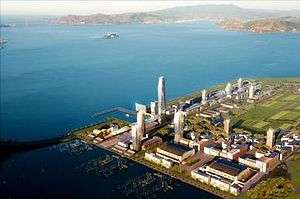Treasure Island Development

The Treasure Island Development is an approved 405-acre (164 ha) redevelopment project on Treasure Island and parts of Yerba Buena Island in San Francisco Bay between San Francisco and Oakland, within San Francisco city limits. The Treasure Island Development Authority (TIDA) is a nonprofit organization formed to oversee the economic development of the former naval station. Treasure Island's development was set to break ground during mid-2012.[1] However, on April 12, 2013, The San Francisco Chronicle reported that the deal has collapsed, with the Chinese investors from China Development Bank and China Railway Construction Corporation withdrawing from the project.[2] The Treasure Island Project is now being developed by a joint venture between Lennar Corporation and Kenwood Investments.[3] The development is expected to cost US$1.5 billion.[3]
Treasure Island Development Authority
The Treasure Island Development Authority (TIDA) is a nonprofit organization city agency that oversees the economic development of Treasure Island. The Authority has a seven-member Board of Directors who were appointed by the Mayor of San Francisco, Ed Lee. The Board of Directors oversees the goal of reusing the island in an environmentally and economically viable way, as well as creating and minting the master development plan.[4] The current members of TIDA[5] are:
| Name |
|---|
| Linda Fadeke Richardson, President |
| Larry Mazzola, Jr., Vice-President |
| Jean-Paul Samaha, Secretary |
| Mark Dunlop, Chief Financial Officer |
| Dr. Tomás Aragón |
| V. Fei Tsen |
| (vacant seat) |
| Supervisor Jane Kim - Ex-officio |
TIDA strives to achieve success in the following goals: "Leadership in Sustainability, Establishing a Regional Destination, Unique San Francisco Neighborhood, Creating Community Benefits/ Job Opportunities"[6]
Master Plan
The master plan calls for all residences to be within a 10-minute walk of all basic goods. A new ferry terminal would connect to a retail center as part of an urban core with a 40-story tower and hotels. Three distinct residential neighborhoods would radiate from the core area and feature townhouses, along with flats and a 14-story residential tower. Also proposed are: five high-rise towers, a K-8 school, 450,000 sq ft (42,000 m2) of retail and commercial buildings, a 275-acre (111 ha) park, a 20-acre (8.1 ha) organic farm, and a 400-slip marina and beach along with state-of-the-art community facilities. The entire redevelopment would take 20 to 30 years to build and would create 8,000 new households for approximately 20,000 people. The development is expected to cost US$1.5 billion.[3]
Buildings In The Development
| Name | Floors |
|---|---|
| Sun Tower | 60 |
| Treasure Island Tower I | 40 |
| Treasure Island Tower II | 40 |
| Treasure Island Tower III | 40 |
| Treasure Island Tower IV | 40 |
Project Status
The City of San Francisco has been working to redevelop the 404-acre island since the U.S. Navy closed its base on the island during 1997. The Treasure Island Project is being developed by a joint venture between Lennar Corporation and Kenwood Investments.[3] On June 7, 2011 the Board of Supervisors Voted 11-0 to approve the project, City officials are now working with the US Navy on a property transfer. The project is scheduled to start during mid-2012, with the construction of homes and retail spaces beginning in 2014 with the first new homes to be occupied by 2015. The project would create 3,000 permanent jobs and 2,000 construction jobs.[7] Currently, Treasure and Yerba Island are home to 1,800 San Franciscan residents, who have access to a budding cultural hub, which includes commercial tenants, restraints, schools, community organizations, event venues, sporting clubs and athletic leagues.[8]
Criticisms
The island's soil might be toxic.[9] The land is prone to subsidence and liquefaction in event of an earthquake.[10]
After the city of San Francisco initially approved the project in 2011, a group called "Citizens for a Sustainable Treasure Island", led by former city supervisor Aaron Peskin, filed a lawsuit against the city and the developer, out of concern that the project's impact on environment and traffic had not been properly reviewed.[11] The courts rejected the complaint, with the California Supreme Court declining an appeal in October 2014.[11]
See also
References
- ↑ Amy Clemens (November 2007). "How high San Francisco? Treasure Island tower raises important questions". The Sierra Club Yodeler. Retrieved 1 September 2010.
- ↑ Matier, Phillip; Ross, Andrew (April 11, 2013). "S-F-China-development-deal-falls-apart". The San Francisco Chronicle.
- 1 2 3 4 Matlock, Kelly. "Reawakening Treasure Island". NewcitySkyline. Archived from the original on 2008-05-31. Retrieved 16 November 2010.
- ↑ http://sftreasureisland.org/about-tida
- ↑ http://sftreasureisland.org/board-directors
- ↑ http://sftreasureisland.org/development-project
- ↑ kane, will (June 8, 2011). "S.F. approves Treasure Island plan". sfgate. Retrieved June 8, 2011.
- ↑ http://sftreasureisland.org/visit-treasure-and-yerba-buena-islands
- ↑ http://www.sfgate.com/bayarea/article/Is-Treasure-Island-toxic-Residents-worries-grow-5238789.php
- ↑ http://www.unh.edu/nges/treasure.html
- 1 2 Wang, Kristy (2014-12-10). "At Last, Thousands of New Housing Units on the Way in SF". SPUR. Retrieved 2015-11-01.
External links and further reading
- Treasure Island official website at the City and County of San Francisco
- Information about the development from the SF Office of Economic and Workforce Development
- "Plan for Treasure Island Clears Hurdle, but Serious Issues Remain" article by Zusha Elinson in The New York Times April 23, 2011
- Through two mayors, connected island developers cultivated profitable deal Public Press 2010
- Specter of conflict of interest for Newsom / Developer, fund-raiser seeks Treasure Island deal SFGate 2004
- Treasure Island Trouble Has Grand Jury Writing Mad / Report takes special slam at S.F. mayor SFGATE 1998
Coordinates: 37°49′33″N 122°22′30″W / 37.825956°N 122.375122°W